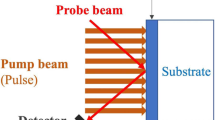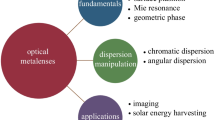Abstract
The Fresnel reflections occurring at the interfaces of a silicon wafer shall be drastically reduced by reactive ion beam etching of so called moth-eye structures into both surfaces of the wafer. This kind of impedance matching is advantageous to a multilayer interference system when the silicon wafer shall be used as an entrance window for high temperature thermopile infrared radiation sensors and emitters. The transmission was measured to be increased by more then 60%, compared to a polished silicon wafer.
Similar content being viewed by others
Author information
Authors and Affiliations
Corresponding author
Additional information
The authors wish to thank Dr. Albrecht Lerm, and Jürgen Müller, Institute for Physical High Technology, for their advice making these investigations.
Rights and permissions
About this article
Cite this article
Glaser, T., Ihring, A., Morgenroth, W. et al. High temperature resistant antireflective moth-eye structures for infrared radiation sensors. Microsystem Technologies 11, 86–90 (2005). https://doi.org/10.1007/s00542-004-0412-5
Received:
Accepted:
Issue Date:
DOI: https://doi.org/10.1007/s00542-004-0412-5




